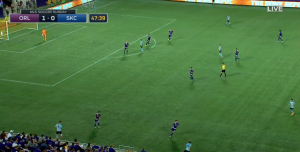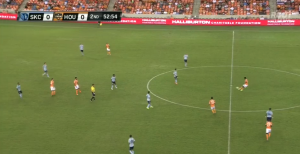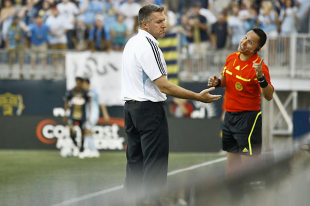Photo: Nicolae Stoian
Sporting Kansas City emerged under Peter Vermes in 2011 as a frenetic, high scoring menace that, much like Peter Nowak’s ego, expanded to fill whatever space it was in.
KC spread the field to its limits and ushered absurd athletes like CJ Sapong, Roger Espinoza, and Kei Kamara through gaps in stretched defenses. They won the Eastern Conference but lost to Dom Kinnear’s brutally efficient Houston Dynamo in the conference finals.
That offseason, Kansas City drafted Dom Dwyer 16th overall in the SuperDraft. The roster remained largely unchanged.
They topped the Eastern Conference again, and once more lost fell victim to Dom Kinnear’s still-brutal, still-efficient Dynamo.
They also won the US Open Cup.
Contrast this with the Philadelphia Union. They emerged in 2011 under Peter Nowak as a claustrophobic defensive side with a semi-functional attack built around Carlos Ruiz. Like Kansas City, Philly was knocked out of the playoffs by the Houston Dynamo. They passed over Dom Dwyer to select Chandler Hoffman. The roster was overhauled, and Porfirio Lopez and Gabriel Gomez were brought in to be regulars.
Peter Nowak was fired on June 13.
Ch-ch-ch-changes
The story of these two clubs is about change. One has changed in subtle ways, from a team that stretched the field horizontally to one that stretches it vertically (but not in that pejorative way). The other has changed drastically, going from one of the league’s best defenses in front of a commanding goalkeeper to one of the league’s worst defenses in front of a bridge game’s worth of goalies.
For Kansas City, Wednesday night’s US Open Cup final is about validating the new direction Peter Vermes is taking his squad. Benny Feilhaber’s deep vein of form is both impressive and damning: KC remains one-dimensional, living and dying on the sword of an imperfect high press. Despite this, Vermes will be granted more time to tweak and build his roster because he has proven himself to be a difference-maker. His young team lifted the US Open Cup and defeated a very good Seattle Sounders side in a not very good final. A more experienced side outlasted Real Salt Lake for the 2013 MLS Cup. In both cases, Vermes took the lessons he learned from notable difference-maker Dom Kinnear and translated them into trophies.
For Philadelphia Union, Wednesday night’s final is about justification. When Vermes fell flat on his face against Dom Kinnear in back-to-back seasons, he had the strength of his team’s regular season performances to land on. Jim Curtin has no such cushion. When the Union have absolutely needed to win — against Columbus last season, against Seattle at home in the 2014 USOC final — they have come up short. Yet, Curtin has ownership’s support to build on a foundation of Tranquillo Barnetta, Maurice Edu, and CJ Sapong. Whether you believe it is right or wrong, lifting a cup will turn into strong justification for continuing with Curtin and Chris Albright.
Beating a Kansas City side that is 11 points ahead of the Union (with a game in hand) in league play will show that Curtin can be a difference-maker.
Big bad Kansas City
The Sporting Kansas City teams that proved Peter Vermes’ coaching bona fides mastered the dark art of isolation. By spreading the field they created favorable matchups in the final third that allowed Kei Kamara, Teal Bunbury, and CJ Sapong to overpower and outmaneuver defenders. There was simply too much strength and speed on the field at one time; central defenders cheated wide to support overmatched fullbacks and the space they left behind was filled by the energetic Roger Espinoza and the sneaky Graham Zusi.
All of this deliberate spacing started in back, where KC pushed the fullbacks extremely wide, using the passing range of Matt Besler and Aurelien Collin to move the ball quickly to the wings. Once there, the fullbacks would advance the ball and find midfielders who were always willing to make an angled run then push the ball back out wide to a winger. It is a fairly formulaic approach to moving the ball, but it was only possible because the opposing defenses were too stretched to effectively close down the ball carrier.
Issues arose when dour, stolid teams like Houston simply moved their entire defensive formation side to side without aggressively attacking the man on the ball. KC needed to disrupt the opposition’s shape in order to create situations in which Kamara and Sapong could take on defenders alone. Additionally, forcing teams to commit a central defender or central midfielder (instead of a wide midfielder) to help on the edges produced the numbers in the middle that turned half chances into big ones.
Kansas City’s subtle strategic changes were driven by circumstance, but they also have Vermes’ fingerprints all over them. First, Kamara sailed for England. Then, Dom Dwyer emerged as the legitimate central striker that CJ Sapong and Teal Bunbury were supposed to become. Third, Oriol Rosell grew into a terrifyingly effective destroyer deep in midfield. Fourth, Benny Feilhaber needed a new home after a tumultuous but productive spell in New England.
Kamara’s farewell initiated a waterfall of adjustments. Graham Zusi eventually found a home on the wing and became what at the time appeared to be an American Dirk Kuyt. With Zusi’s effectiveness on the wing and Rosell’s growth in the middle — and let’s not forget Roger Espinoza’s defection for Wigan United — Vermes’ had to figure out what to do in the center of the park. Feilhaber was brought in to spread the ball around the pitch and provide some of the attacking impetus that drained from the side when Espinoza left. Dwyer got his chance in the final two months of 2013, and his movement was twisting defensive lines in knots, but the young striker often ended up in the channels, pulling defenders toward the wings and canceling out the space that had been so vital to the 2011-2012 teams. Dwyer’s positives far outweighed his negatives, however, and when KC won the 2013 MLS Cup, it seemed as though all of these minor adjustments had set the club up as a potential dynasty.
But what at first appeared to be another minor change upset the team’s balance, and it has never fully recovered.
Rosell pulls the rug
Oriol Rosell, the Catalan holding midfielder who always seemed to be doing very little but was actually building an impressive wall in front of the defense, was sold. And in a story that Arsenal fans know all too well, he was never adequately replaced.
Rosell’s secret is that he never tried to do too much. He smartly closed off space in front of the central defenders and played safely behind Feilhaber and Paulo Nagamura when they executed a high press. Without Rosell, Kansas City fell apart. But not all at once.
First they posted an eight game unbeaten streak, but cracks were developing. Where they were once shutting teams out, they were now winning 2-1. As opposing managers realized KC was leaving spaces to counterattack, they adjusted and began punishing the formerly impregnable defense.
Before August, Kansas City gave up three goals or more exactly zero times. In the final thirteen matches they allowed three or more goals in four games. Through 21 matches, KC allowed 0.90 goals per game. From August onward that number shot up to 1.69.
Remember, though, this is a story of subtle changes. Vermes did not tear the whole thing down, but the man who brought the 4-3-3 to prominence in MLS modified his approach.

Nemeth (bottom) pulls his defender wide. Guess which gigantic hole Feilhaber puts the ball through when he gets it?
2015 tweaks
Krisztian Nemeth joined as a winger and Roger Espinoza returned to the squad. The 2015 midfield, then, had no true holding midfielder. But it did have Benny Feilhaber, and Vermes knew he had more to offer.
The Feilhaber-Espinoza-Nagamura midfield that has been KC’s best in 2015 did not immediately jell. These are three players who are all used to playing with a safety net behind them in the form of a holding midfielder. The new plan was to execute a wolfpack-type press that required all three to be as smart with their defensive running as they were with their attacking movement. If Feilhaber — normally the most central — pressured the ball, either Espinoza or Nagamura had to help and the other had to hold the middle. If both pressed, KC’s midfield became a counterattacking runway. If neither pressed, Feilhaber ended up looking like an overeager puppy.
When it worked, it was near-lethal. Kansas City has by far the most tackles and interceptions per match in MLS, and a considerable number of those defensive actions occur in the opponent’s half. Zusi and Nemeth have learned to pull wide to create channels for Dwyer then slip behind the defensive line whenever Feilhaber finds the ball off a turnover. Teams that seek to close down KC’s wide men early will be punished with throughball after throughball between the fullback and center back.
However, an injury to Espinoza has thrown off the midfield balance. Since the Honduran went down, KC has won only twice, and they have endured ugly losses to San Jose, Colorado, Orlando, and Houston.
So far, Vermes’ solution has been an out-and-out defensive midfield role for Soni Mustivar, a Haitian whose play is best captured by a “shrug” emoji. Like Rosell, Mustivar has a tendency to go unnoticed for extended periods of matches. Unlike Rosell, this is not because he is sucking the air directly out of opposing offenses’ proverbial lungs.
 With Mustivar in midfield, Kansas City plays what amounts to a 4-1-4-1. Problems occur when Feilhaber and Nagamura press and Mustivar remains in a traditional holding role. This essentially creates an extra line in defense (the “1” between the “4”s) and means there is more space than necessary between Feilhaber and Nagamura and the defensive line. Such appetizing space is quickly devoured by wingers who cut inside, pulling their defender and opening space for the dangerous crosses of Chance Myers and Seth Sinovic (Sporting has scored 14 headed goals this season). Alternatively, attacking midfielders drift into that space and drag Mustivar out of the middle, making KC susceptible to runs directly up the center of the park. Not only is that extremely dangerous, but it looks really, really bad on film.
With Mustivar in midfield, Kansas City plays what amounts to a 4-1-4-1. Problems occur when Feilhaber and Nagamura press and Mustivar remains in a traditional holding role. This essentially creates an extra line in defense (the “1” between the “4”s) and means there is more space than necessary between Feilhaber and Nagamura and the defensive line. Such appetizing space is quickly devoured by wingers who cut inside, pulling their defender and opening space for the dangerous crosses of Chance Myers and Seth Sinovic (Sporting has scored 14 headed goals this season). Alternatively, attacking midfielders drift into that space and drag Mustivar out of the middle, making KC susceptible to runs directly up the center of the park. Not only is that extremely dangerous, but it looks really, really bad on film.
No doubt that when Vermes acquired Amobi Okugo from Orlando City he was hoping Okugo could pair athleticism and intelligence in a way that allows KC to play with a holding midfielder while remaining compact. So far, though, a knee injury has kept the former Union man from an extended run on the pitch.
Wednesday’s squad
And so, this is the team that Peter Vermes brings to PPL Park on Wednesday evening. It is a team that can absolutely suffocate a defense that moves the ball slowly and indecisively. But it is also a team with a wonky, inconsistent midfield. They seek turnovers in the opponent’s half and attack with speed when they get them. Through Feilhaber, they stretch the field vertically without resorting to booting it long. With Nemeth they take the scoring burden off of Dwyer and pin defenses deep to allow the midfield to run through in support of the front line.
Sporting Kansas City are very good but, currently, still quite flawed.
And they are coached by a man with a US Open Cup and a MLS Cup to his name. He has been spectacularly mocked by Union fans in the past, but he has proven himself to be a difference-maker. As Jim Curtin said, Peter Vermes’ teams have an identity, though not an inflexible one.
Curtin would like to give the Union an identity as well. To do it, he will have to be the difference-maker Wednesday night and outthink a man he clearly respects.
Only the future of the franchise is riding on it. No pressure.



turn and face the day…ch ch changes.
.
.
The truth of this article is hard to swallow on one hand but presents a distinct hopefulness on the other. That about sums up our Philadelphia Union.
.
Ummm…no prediction?
Last time they played them the Union midfield had theirs for lunch. I think the Union actually have a shot on Wednesday.
@Pachy – I’ll do a more traditional preview tomorrow with a prediction.
Per Vermes, Nemeth will be a game day decision. Hasn’t fully recovered from the injury against FC Dallas and isn’t practicing 100%. Will most likely be a sub player. Melia is questionable as well.
“Graham Zusi eventually found a home on the wing and became what at the time appeared to be an American Dirk Kuyt.”
–
I laughed at this sentence, probably because I always thought that both players were generally overrated. Perhaps that was your intent, but if not, a hearty well done to you, sir.
Speaking of things Sporting: Empire of Soccer reports Union sign Octavio Zambrano as first ever Sporting Director. Bigger than tomorrow’s result?